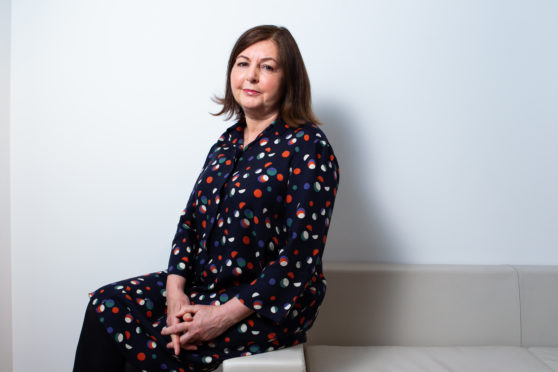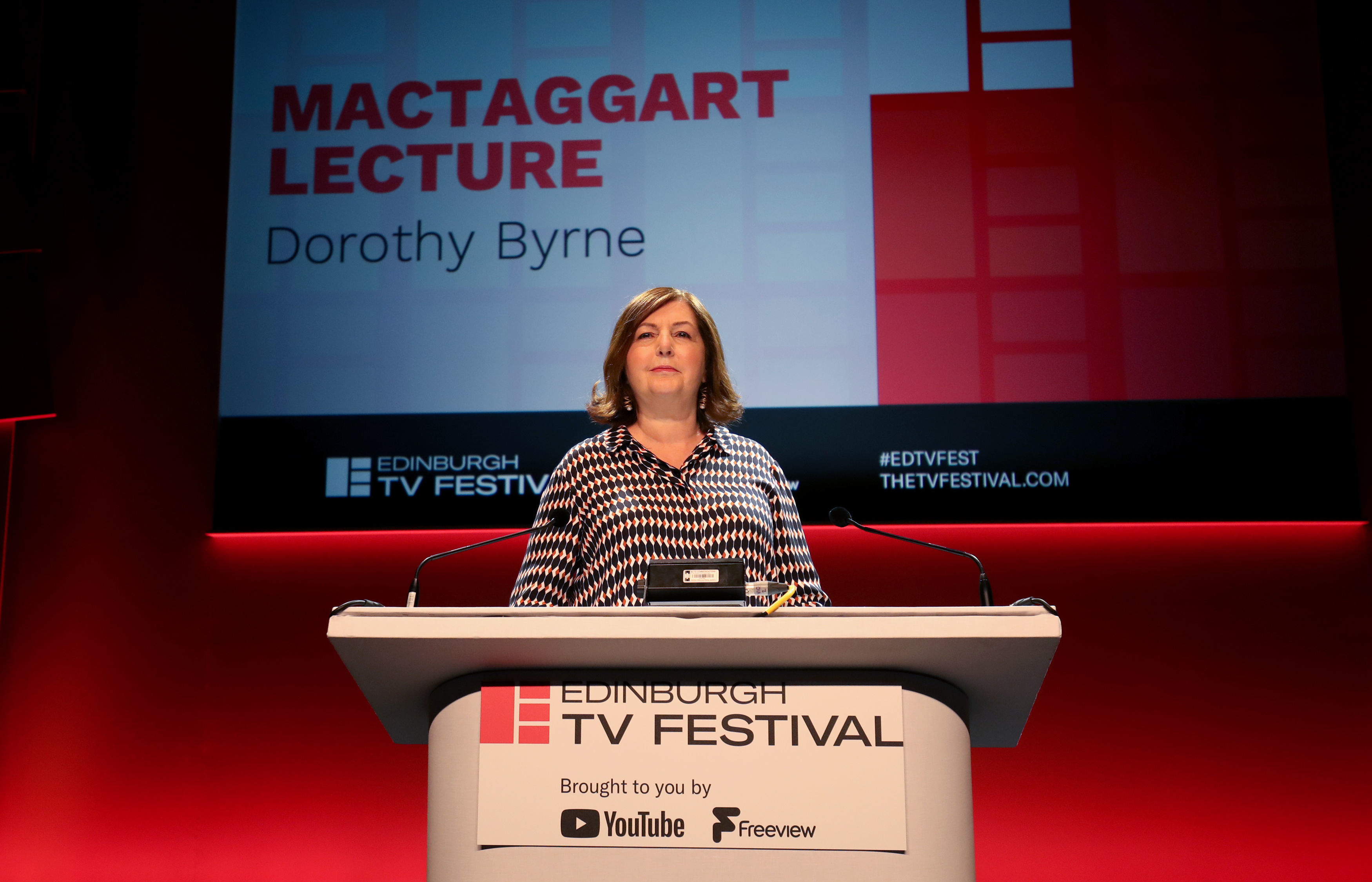
Sitting in the departure lounge at Edinburgh Airport, Dorothy Byrne finally took a breath.
In the 48 hours since delivering a barn-storming speech in the capital, Channel 4’s head of news and current affairs had been at the eye of a tornado after unleashing a funny but ferocious takedown of sexists in her industry while sounding a clarion call for broadcast journalism to step up to the plate at a time of global crisis.
Her MacTaggart Lecture, the keynote speech at the annual Edinburgh Television Festival, made headlines of its own after Byrne waded in to condemn male colleagues, past and possibly present, of abusing their position; give a personal account of being harassed on her first day at work; suggest a previous MacTaggart lecturer sexually assaulted women; accuse Boris Johnson and Jeremy Corbyn of cowardice for dodging interviews; compare the Prime Minister to Vladimir Putin for ducking proper interrogation; and lambast the lack of diversity in TV; while finding time to raise the subject of the menopause and men’s ignorance about it.
Byrne hoped her wise-cracking but serious-minded speech might trigger a reaction. And she was not disappointed. Before her flight on Friday, the Paisley-born broadcaster said: “It’s been extraordinary and I’ve been overwhelmed by the reaction. Normally I’m an obscure person, so it’s a shock to the system.
“I felt like Cinderella for the day, but I know my life will go back to normal again.
“I’ve received hundreds of messages and women have come up to me in the street and embraced me.
“I felt some of the things really needed to be said. I knew I wanted to speak about being a woman, because I suffered a lot throughout my career with harassment and occasionally actual attacks, and I know a lot of women have.
“I wanted to make clear to any men who were that way inclined that women talk. We know who they are.
“If morality doesn’t stop them behaving badly, then let fear stop them because I think a lot of women have come out and spoken, but there are more who have not yet spoken.”
In her lecture, while talking of the media figures who had previously given the address, Dorothy “spotted one name among my predecessors who has not yet had the comeuppance he deserves for his assaults on women”.
The annual lecture started in 1976 and has been delivered by only five other women, but Byrne said it wasn’t her place to name anyone.
“It wasn’t a person who assaulted me, so I think it’s for the victims of assault to make their own decision as to whether they want to speak about someone, about whether they want to go to the police, to employers or even speak to the press. That’s for them to say, not for me to do.
“The MeToo movement has been fantastic. It’s encouraged a lot of women to speak out, but a lot don’t.
“I’ve had women say to me, ‘I don’t want to be defined by being a victim of assault’.
“There are quite a number of men in TV who think they have got away with it or can get away with it, and I don’t think they should.”
Byrne has been around newsrooms for more than 40 years and, although she says the culture isn’t as bad as when she started out, neither is it totally gone.
“We have to root it out completely, not just because it’s wrong and some of it is criminal, but also because it’s so undermining to women. It undermines you professionally if a man assaults or harasses you.”
Byrne, who dismisses the “fake news” term as a way to belittle journalism, always had an interest in politics and international affairs growing up.
She was born in Paisley, moved to Edinburgh when she was six and then to Lancashire when she was nine, but regards herself as “completely Scottish”.
Her dad was in war pensions, her mum’s side of the family civil servants and teachers, but, after doing voluntary service overseas post-university, the issues Dorothy encountered led her into journalism.
She worked on local papers at first – the Waltham Forest Guardian in East London and the Northern Echo in the north-east of England – then on to TV with Granada Reports.
Byrne moved to World In Action, became editor of another ITV series, Big Story, before crossing to Channel 4 20 years ago as editor of Dispatches and then into her current role as head of news and current affairs. In her speech, she lamented that all the women she started out with had left the industry and insisted more had to be done to keep females in the workplace, including offering flexible and reduced hours.
So, why did she flourish?
“I think I’m a very resilient person, but also because I was a single parent and I needed to work. Maybe some other women had another breadwinner in the house and thought, ‘this is a bit much, I’ll just stop’, but I had to keep working anyway.
“I’m also very passionate about what I do. I love it.”
She is also passionate about today’s politicians routinely refusing in-depth TV interviews.
“This has happened in a short period of time,” she said. “Theresa May reduced access to the Prime Minister, access to Jeremy Corbyn has been reduced, and the situation has worsened with Boris Johnson, before and since he became Prime Minister.
“If he wants to answer questions on Facebook, as he has just done, that’s fine. But in choosing the questions he takes, and there being no follow-up to his answers, it’s not the same as being held to account on television.
“I think they feel they can get away with not doing these interviews and people won’t complain, which is why I have complained, and why others should complain.
“I’m complaining on behalf of the voters, because journalists play a key role in democracy. You can’t have a proper democracy without a free press in which journalists have proper access to politicians and to question them.
“Secondly, if they are confident in their policies and believe in them, come on TV and justify them.
“I’m very worried about what’s going to happen in the next election. Are voters really going to be allowed to hear properly from politicians, to hear all of their policies and arguments?”
Despite her criticism, Byrne says she respects politicians.
“In my experience, almost all politicians go into politics because they genuinely think they can play a role in making our country better.”
As she returns to her desk in London, she hopes her speech might help encourage a change, among men, among politicians.
“I hope other people will come out and see we must get politicians to be held to account. This isn’t just for journalists, it’s for the public and other politicians to say, ‘come on, go on TV’.”
She added: “I’m proud of what I’ve achieved. I’ve worked very hard. But I’m also conscious that I’m lucky, too.
“People have helped me on the way – everybody needs help – and I hope to be able to help other people now, too.”

Enjoy the convenience of having The Sunday Post delivered as a digital ePaper straight to your smartphone, tablet or computer.
Subscribe for only £5.49 a month and enjoy all the benefits of the printed paper as a digital replica.
Subscribe © Jane Barlow/PA Wire
© Jane Barlow/PA Wire